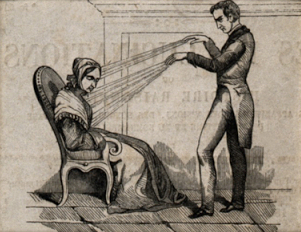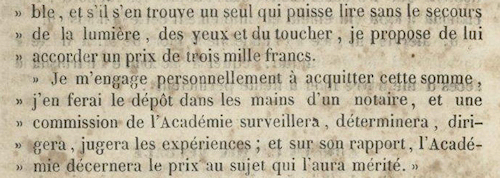MARIANO TOMATISWONDER INJECTORItalian writer and magician
|
 Magic & HypnosisMagic and hypnosis: keeping trickery out of the door Posted on monday 9 june 2014, 60 days before scifoo14 • Written by Mariano Tomatis Intersections are fascinating areas. In the region between Science and Magic you can stumble upon Hypnosis, a fascinating and controversial topic. Originating from Mesmerism — a practice based on a (hypotetical) invisible natural force exerted by animals, the “animal magnetism” — it became part of medical science with James Braid (1795-1860), who coined the term “hypnotism” (1). Interestingly, Braid started suspecting fraud, but upon witnessing astonishing results (and after making certain tests on the magnetized subjects himself) he became convinced the phenomena were genuine. Part of his skepticism was well-grounded. In addition to its medical applications, Mesmerism ispired theatrical performances in which stage magnetists used magic tricks to simulate the effects of hypnosis. After two centuries, it is still difficult to draw a clear line between ordinary suggestion and the so called “hypnotic trance”. Working together with psychologists, a well trained magician may be extremely helpful in sorting out the intricate combination of the factors influencing hypnosis — on a stage, but also in research institutes — both psychological (such as participant selection, ordinary suggestibility, peer pressure and social compliance) and physical (involving stagecraft, manipulation, and trickery). My book Te lo leggo nella mente (“I read it in your mind”) is a wide analysis of this liminal area. Two little holes in the taffeta Long before James Randi’s One Million Dollar Paranormal Challenge, in 19th century the Parisian Académie Royale de Médecine offered 3,000 Francs to anyone who could demonstrate the ability of reading while blindfolded during an hypnotic trance. On 5 September 1837 Claude Burdin announced: If we find one that can read without the aid of light, eyes and touch, I propose to give him a price of three thousand Francs. I am personally committed to pay this sum, I will deposit in the hands of a notary, and a commission of the Academy will monitor, determine, direct, judge the tests; and after their report, the Academy will award the prize to the subject that has deserved it. (2)  E. Pariset, L.-Ch. Roche e J.-B. Bousquet, Bulletin de l’Académie Royale It is really funny to read about the daring adventures of the competitors. The eleven year old daughter of Pigeaire, a veterinary from Montpellier, was tested on 7 July 1838. Between tears and “contortions of the muscles of her face,” (3) the blindfolded girl read two stanzas of a poem from a book opened at random. Checking the fabric of taffeta with which she had made the bandage, two members of the Academy “discovered two little holes” and revealed the fraud.  «Two Academy members, at the end, by checking the taffeta discovered two little holes; they raised the suspicion that the somnambulist was looking through them.» in “Premi proposti dalla R. Accademia delle scienze di Parigi”, Biblioteca italiana ossia giornale di letteratura, scienze ed arti, Vol. 92, Milan (Italy), October-December 1838, p. 139. Hypnosis beyond trickery Studies about hypnosis have improved a lot during recent decades, keeping trickery out of the door and focusing in identifying types of high hypnotizables individuals. Starting from the two subgroups identified by Deirdre Barrett (“fantasizers” and “dissociaters” (4)) I stumbled upon her recent works about the contributions of dreams to creativity and problem solving — and I felt like a dog with two tails. And the tails became four when I read about her studies on “supernormal stimuli” — artificial objects pulling an instinct more strongly than that for which they evolved. For their role in governing the behavior of humans, they are really interesting from the point of view of a magician, using technology and trickery to enhance the state of Wonder in the audience by steering (and misdirecting) perceptions. Supernormal stimuli have a counterpart in the idea of hyperreality and the inability to distinguish reality from a simulation of reality is at the very core of a magic experience properly designed. _________________ (1) James Braid, Braid on hypnotism. Neurypnology, George Redway, London 1899. (2) «[…] s’il s’en trouve un seul qui puisse lire sans le secours de la lumière , des yeux et du toucher, je propose de lui accorder un prix de trois mille francs. Je m’engage personnellement à acquitter cette somme, j’en ferai le dépôt dans les mains d’un notaire, et une commission de l’Académie surveillera , déterminera , dirigéra, jugera les expériences ; et sur son rapport, l’Académie décernera le prix au sujet qui l’aura mérité.» in E. Pariset, L.-Ch. Roche e J.-B. Bousquet, Bulletin de l’Académie Royale de Médecine, Tome II, J.-B. Baillière, Paris 1837-1838, p. 19. (4) Deirdre Barrett, “The Power of Hypnosis”, Psychology Today. You could be interested also in: |
 Science Foo Camp (or “Sci Foo”) is an invitation-only gathering organized by Digital Science, O'Reilly Media, and Google, with support from Nature. The 9th edition of Sci Foo takes place on 8-10 August 2014 at the Googleplex in Mountain View, CA. Lord Martin Rees has defined it as “a sort of mini Woodstock of the Mind”. Participants include researchers, writers, educators, artists, policy makers, investors, and other thought leaders, all doing groundbreaking work in diverse areas of science and technology.
Science Foo Camp (or “Sci Foo”) is an invitation-only gathering organized by Digital Science, O'Reilly Media, and Google, with support from Nature. The 9th edition of Sci Foo takes place on 8-10 August 2014 at the Googleplex in Mountain View, CA. Lord Martin Rees has defined it as “a sort of mini Woodstock of the Mind”. Participants include researchers, writers, educators, artists, policy makers, investors, and other thought leaders, all doing groundbreaking work in diverse areas of science and technology.